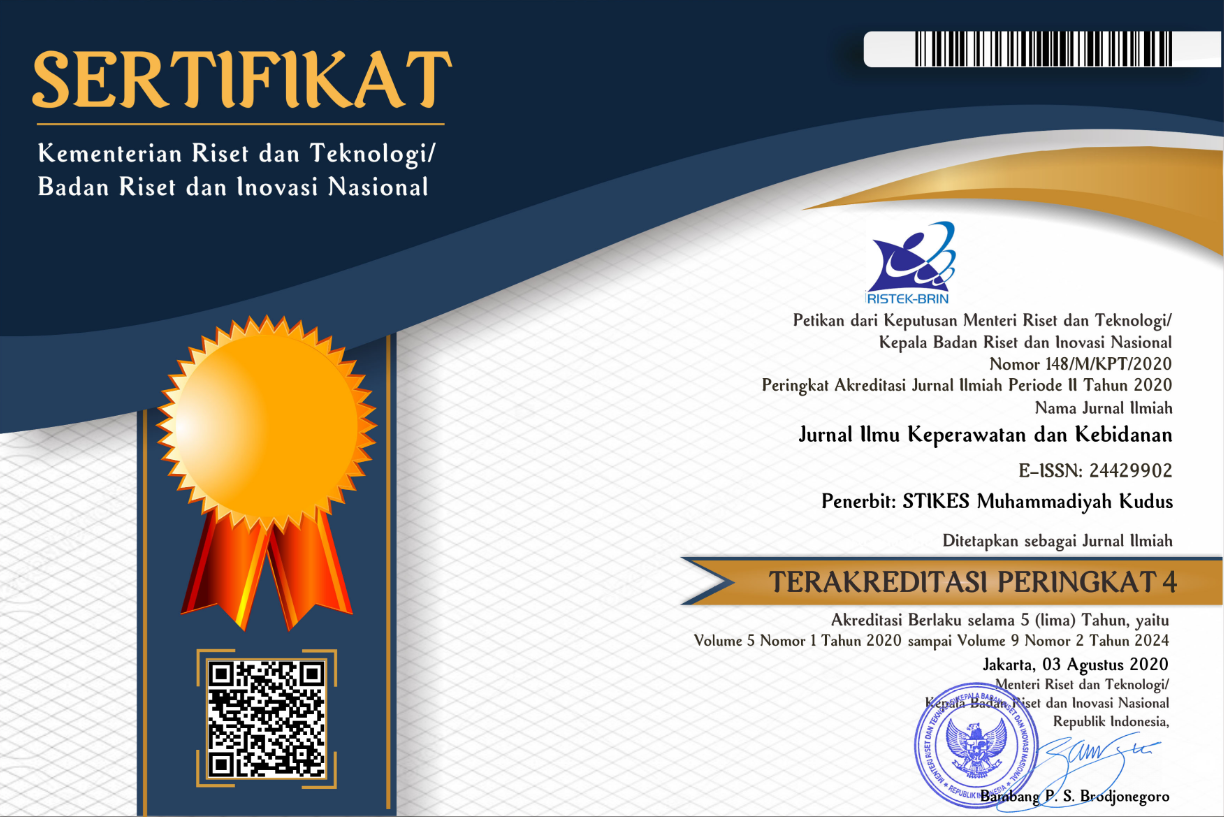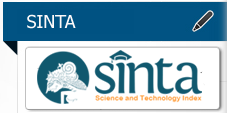HUBUNGAN INDEKS MASSA TUBUH DENGAN KEJADIAN ANEMIA PADA WANITA USIA SUBUR PRANIKAH
Abstract
Abstrak
Wanita Usia Subur (WUS) merupakan kelompok usia dengan prevalensi anemia yang cukup tinggi, di Indonesia mengalami peningkatan dari 19,7%(2007) menjadi 22,4% (2013). Status besi WUS pranikah berdampak pada outcome maternal dan neonatal saat kehamilan. Hubungan Indeks Massa Tubuh (IMT) dan anemia masih kontroversial. Berat badan kurus merupakan indikasi rendahnya asupan mikronutrien yang berhubungan dengan anemia. Pada studi lain, berat badan berlebih/ obesitas meningkatkan resiko anemia karena peningkatan sitokin inflamasi (Interleukin-6) yang menstimulasi peningkatan hepsidin dan penurunan penyerapan besi. Tujuan penelitian ini adalah menganalisis hubungan Indeks Massa Tubuh dengan kejadian anemia pada WUS pranikah. Penelitian ini berjenis analitik observasional dengan metode pendekatan cross sectional dilakukan pada 36 WUS pranikah ( 18 anemia dan 18 tidak anemia) di Kantor Urusan Agama (KUA) Kecamatan Koto Tangah Kota Padang. Pengambilan sampel dilakukan secara consecutive sampling. Pengukuran tinggi badan menggunakan microtoice dan berat badan menggunakan timbangan pegas. Pemeriksaan hemoglobin dengan metode sianmethemoglobin di Laboratorium Biokimia Universitas Andalas. Uji Bivariat dilakukan dengan uji Chi Square.Hasil penelitian menunjukkanWUS dengan IMT berlebih merupakan persentase terbesar (66,7%) yang ditemukan pada kelompok anemia. Tidak terdapat hubungan antara IMT dengan kejadian anemia dengan nilai p 0,7 (p>0,05). Kesimpulan penelitian ini adalah tidak terdapat hubungan antara IMT dengan kejadian anemia.
Kata Kunci: Indeks Massa Tubuh, Kejadian Anemia
Abstract
Women of Reproductive Age (WRA) are an age group with a fairly high anemia prevalence in Indonesia, increasing from 19.7% (2007) to 22.4% (2013). Iron status of premarital women affects maternal and neonatal outcomes during pregnancy. The relationship between the Body Mass Index (BMI) and anemia is controversial. Underweight indicates of inadequate dietary intake of micronutrients associated with anemia. In other study, overweight/obesity also increase anemia risk because release of proinflammatory cytokines (Interleukin-6) and which stimulates release of hepsidin and decrease iron absorbtion. The purpose of this study was to analyze the relationship between body mass index with the incidence of anemia in premarital WRA. This research was an observational analytic type with a cross sectional approach performed on 36 premarital WRA (18 with anemia and 18 without anemia) in Koto Tangah District, Padang. Sampling was done by consecutive sampling. Body height is measured by microtoice and body weight is measured by manual scale. Hemoglobin was examined with the cyanmethemoglobin method at the Andalas University Biochemistry. Bivariate test was carried out by Chi Square test. The results showed overweight women is the highest percentage (66,7%) in anemia group. There was no relationship between BMI and the incidence of anemia (p > 0.05). The study concluded that there was no relationship between BMI and anemia.
Keywords: Body Mass Index, Anemia
Full Text:
PDFReferences
Bansal, A. Sharma, AK. Sharma, S. Sujatha, R. (2016). Iron deficiency anaemia in women of reproductive age group attending a tertiary care hospital. Indian Journal Scientic Research.Vol. 7.pp.109-1013
Ganz,T and Nemeth,E. (2012). Hepcidin and iron homeostatis. National Institute of Health Public Access.pp.1434–1443. doi:10.1016/j.bbamcr.2012.01.014.
Ghose, B. Yaya, S. and Tang,S. (2016). Anemia status in relation to body mass index among women of childbearing age in Bangladesh. Asia Pacific Journal of Public Health. doi: 10.1177/1010539516660374
Gibney, MJ (eds). (2009). Gizi Kesehatan Masyarakat (Public Health Nutrition). Jakarta : EGC
Hall, JE. (2011). Buku ajar fisiologi kedokteran (Edisi 12). Jakarta : EGC
Kementerian Kesehatan RI. (2007). Riset Kesehatan Dasar 2007. https://www.k4health.org/sites/default/files/laporanNasional%20Riskesdas%202007.pdf
Kemenkes. (2013). Riset Kesehatan Dasar 2013. www.depkes.go.id/ resources/download/general/Hasil%20Riskesdas%202013.pd
Kwapisz,J. Slomka, Zekanowska,E. (2009). Hepcidin and its role in iron homeostasis. The Journal of The International Federation of Clinical Chemistry and Laboratory Medicine .Vol 20. No 2. pp.124-128
Lopez, AC. Osendarp, SJM. Boonstra, AM. Aeberli, I. Salazar,FG. Feskens, E. et al. (2011). Sharply higher rates of iron deficiency in obese Mexican women and children are predicted by obesity-related inflammation rather than by differences in dietary iron intake. American Journal Clinical Nutrition. Vol. 93. No. pp. 975-983. doi: 10.3945/ajcn.110.005439
McClung, JP. Karl, JP. (2008). Iron deficiency and obesity: the contribution of inflammation and diminished iron absorption. Nutrition Reviews. Vol. 67.pp.100- 104. doi:10.1111/j.1753-4887.2008.00145.x
Nagababu, E. Gulyani,S. Earley,CJ. Cutler,RG. Mattson,MP. Rifkind,JM. (2008). Iron-Deficiency Anemia Enhances Red Blood Cell Oxidative Stress. Free Radical Research. Vol.42. No.9. pp.824–829. doi:10.1080/10715760802459879.
Permaesih,D. Herman,S. (2005). Faktor-faktor yang mempengaruhi anemia pada remaja. Buletin Penelitian Kesehatan. Vol. 33. No. 4. Pp.162-171
Qin, Y. Boonstra, A. Pan, X. Yuan, B. Dai, Y. Zhao, J .et al .(2013). Anemia in relation to body mass index and waist circumference among chinese women. Nutrition Journal. Vol. 12. http://www.nutritionj.com/content/12/1/10
Ridwan, Endi. (2012). Kajian Interaksi Zat Besi Dengan Zat Gizi Mikro Lain Dalam Suplementasi (Review Of Interactions Between Iron And Other Micronutrients In Supplementation). Penel Gizi Makan . Vol.35. No. 1. Pp. 49-54
Romero, MM. Flores, RJ. Molina, RV. Ramos, MI. Reali, JY. Sigrist-Flores, SC. et al. (2012). The body mass index (BMI) as a public health tool to predict metabolic syndrome. Journal of Preventive Medicine. Vol.2, No.1, pp.59-66 (2012) http://dx.doi.org/10.4236/ojpm.2012.21009
Sal, E. Yenicesu,I. Celik,N. Pasaoglu,H. Celik, B.Pasaoglu,OT. (2018). Relationship between obesity and iron deficiency anemia: is there a role of hepcidin?. Hematology. DOI: 10.1080/10245332.2018.1423671
Sharma ,J.B. Shankar, M. (2010). Anemia in Pregnancy. JIMSA. Vol. 23. No. 4
Stabler,SP. 2013. Vitamin B12 Deficiency. The new engl and journal of medicine. Vol. 368. Pp.149-60. DOI: 10.1056/NEJMcp1113996
Sukarno, KJ. Marunduh, SR. Pangemanan, DH. (2016). Hubungan indeks massa tubuh dengan kadar hemoglobin pada remaja di Kecamatan Bolangitang Barat Kabupaten Bolaang Mongondow Utara. Jurnal Kedokteran Klinik . Vol. . No 1
Sumarmi, S. Puspitasari,N. Handajani,R. Wirjatmadi, B.(2016). Underweight as a Risk Factor for Iron Depletion and Iron- Deficient Erythropoiesis among Young Women in Rural Areas of East Java, Indonesia. Malaysian Journal of Nutrition. Vol.22. No.2. pp.219-23
Triyonate, EM. Kartini,A. (2015). Faktor determinan anemia pada wanita dewasa usia 23-35 tahun. Journal of Nutrition College. Vol. 4, No. 2. Pp. 259-263
Ugwuja, EU. Ogbonnaya,L. Obuna,AJ. Femiawelegbe, Henry, UC. (2015). Anaemia in relation to body mass index (bmi) and socio-demographic characteristics in adult nigerians in Ebonyi State. Vol.9. No.1. pp.LC04-LC07. doi: 10.7860/jcdr/2015/9811.5485
WHO. (2015). The global prevalence of anaemia in 2011. www.who.int/.../global_prevalence_anaemia_2011/en/
WHO. (2014). Anemia Policy Brief. www.who.int/.../globaltargets _anaemia_policybrief.pdf
WHO.(2011). Haemoglobin concentrations for the diagnosis of anaemia and assessment of severity. www.who.int/vmnis/indicators/haemoglobin/en
WHO. (2011). Prevention of iron deficiency anaemia in adolescents. http://www.who.int/iris/handle/10665/205656
WHO. (2006). Global Database on Body Mass Index. http://apps.who.int/bmi/index.jsp?introPage=intro_3.html
Wirth, JP. Woodruff, BA. Stone, RE. Namaste, SML. (2014). Predictors of anemia in women of reproductive age: Biomarkers Reflecting Inflammation and Nutritional Determinants of Anemia (BRINDA) project. American Journal Clinical Nutrition. pp.16S–27S
Wu, Guoyao. Dietary protein intake and human health. (2016). Food Funct. Vol.7. pp.1251-1265. DOI: 10.1039/c5fo01530h
DOI: https://doi.org/10.26751/jikk.v10i1.584
Refbacks
- There are currently no refbacks.
Universitas Muhammadiyah Kudus - LPPM Universitas Muhammadiyah Kudus
Jl. Ganesha 1 Purwosari Kudus 59316
Tel/ Fax +62-291-437218 Email : lppm@umkudus.ac.id
Jurnal Ilmu Keperawatan dan Kebidanan Indexed by:

This work is licensed under a Creative Commons Attribution-ShareAlike 4.0 International License.













